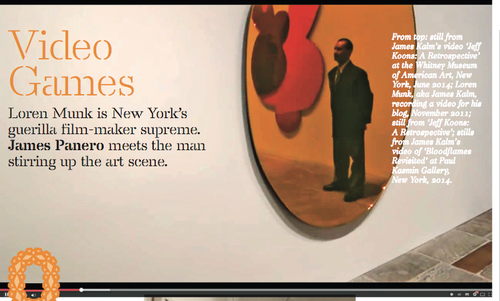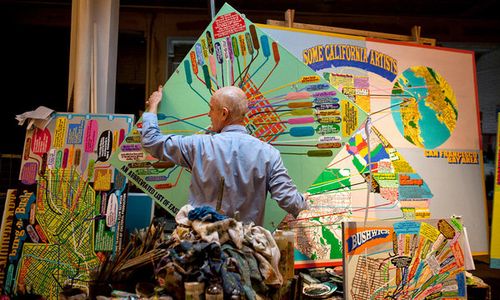Model of the Eisenhower Memorial looking at Independence Ave. GEHRY PARTNERS, LLP
THE WALL STREET JOURNAL
November 13, 2014
Not Like Ike
by James Panero
Plans for the Eisenhower Memorial have turned into another Washington boondoggle.
Imagine if the great Lincoln Memorial had been designed today. No longer would we feature our 16th president enthroned in a Doric temple. No more would we contend with an off-putting set of stairs as we strain to look up at cold, noninteractive marble.
Instead, Lincoln could be brought down to our size. In an immersive multimedia environment, tapping the latest technologies to recall log-cabin life, here we might help Lincoln as a child contend with his humble beginnings. The native vegetation of Kentucky, Indiana and Illinois could be planted on site, part of a LEED-certified green drainage plan. Through the Lincoln E-Memorial app, visitors could test their strength against the famous rail splitter through a game that posts scores directly to Twitter (hashtag: #RailedIt). Just be sure to duck when visiting the “Ford’s Theatre Experience.”
Thankfully, there is little risk of seeing the Lincoln Memorial recast this way. For Marian Anderson, Martin Luther King Jr. and many others, it has served as one of the most famous backdrops of the past century despite its antiquated marble technology. Yet since 1999, Washington’s master planners have been at work on another presidential memorial on the National Mall—for Dwight D. Eisenhower—that will pursue the opposite of the tried and true: a plan that was touted in its 2008 prospectus as a “21st Century memorialization,” using “new avenues” and “the widest possible range of innovative concepts and ideas,” with a “very significant electronic component,” leading to a “new vision for memorialization.”
National memorials have a history of long gestation and partisan controversy. Even the Lincoln Memorial, designed by Henry Bacon with sculpture by Daniel Chester French, completed in 1922, saw its share of criticism. Yet in this classical city, in hindsight, Washington’s traditional monuments have stood the test of time. So why must new mean “new”?
The congressionally authorized Eisenhower Commission certainly believes it got “new” in Frank Gehry, its chosen architect. With a proposal that subverts many of the classically based traditions of memorial design, the core of Gehry’s plan is the periphery: a 447-foot-long metal screen, suspended between 80-foot-tall columns, interwoven with images of trees. “The setting for Eisenhower Square,” reads the Commission website, “will be framed by transparent stainless steel tapestries, which depict the plains of Kansas, representing Eisenhower’s humble beginnings.” This device would serve as the backdrop for the sculptural program playing out in front of it.
In the initial proposal, since amended to include a greater cast of characters, this program centered on a statue of Eisenhower as a barefoot boy. The memorial would also be designed around an app that “will enable visitors to view historical footage, speeches, and events within the context of the physical memorial through augmented reality.”
Should we be surprised that the plan has become more bogged down than the Battle of the Bulge? The design has received widespread criticism—from Justin Shubow of the National Civic Art Society to Sam Roche of the group Right by Ike, not to mention members of Eisenhower’s own family—that has resonated with lawmakers and the general public. The site would also imperil the historic L’Enfant Plan by overlaying Maryland Avenue, between the Air and Space Museum and the Department of Education. In the New Yorker last year, Jeffrey Frank said the design “has managed to achieve something rare in Washington: in true bipartisan spirit, almost everyone hates it.”
This past summer, congressional members of the Committee on Natural Resources issued a 60-page report damning the project as a “five-star folly.” It is easy to see why. Congress has already appropriated $65 million for a project that would cost $100 million or more. Yet without a stone—or screen—in place, $41 million of this funding has already been spent or obligated, including almost $16.4 million for the designer and $13.3 million for administrative support. A $1.4 million fundraising effort slated to generate $35 million in private support has taken in less than $500,000. Meanwhile, the Commission maintains nine full-time employees and six full-and part-time contractors.
Beset by criticism, Congress has rightly halted future funding, some commissioners have resigned and calls have been mounting to scrap the Gehry plan altogether. Bruce Cole, the former head of the National Endowment for the Humanities who was appointed to the Commission a year ago, remains a skeptic. “A great memorial is an exclamation point, not a question mark,” he recently testified.
Yet led by its chairman, Rocco Siciliano, the Commission has dug in. Recent approvals by the National Capital Planning Commission and the U.S. Commission of Fine Arts have been hailed by Gehry defenders as the green light, even if the project has only enough gas to idle at the curb. Of course the bureaucrats behind the wheel still get their salaries. That’s right: Commission staffers will continue to draw down millions of tax dollars regardless of whether anything gets built.
Yet a greater force than self-interest has propelled the memorial to this point: the sometimes blinding mythology of the “new,” where widespread criticism can be mistaken for vindication, and pushback ennobles a self-anointed vanguard. Mr. Siciliano and others may believe they are following the example of the Vietnam Memorial, an unconventional design that overcame initial controversy to win the public over. But criticism alone does not authenticate avant-garde success. An unconventional design may just be bad, and design à la mode risks falling from fashion.
Eisenhower deserves a great national memorial, and it would be wrong to see this battle reduced to a mandate for one style over another. But the critics are right to demand something genuinely revolutionary—a design that is not simply “new,” but new, and that successfully communicates the essence of the man it claims to honor.
After all, here is the Supreme Allied Commander who oversaw the most complex amphibious assault in history. He liberated Europe, went on to become the president of Columbia University and the commander of NATO. As the American president who ended the Korean War, he ushered in a period of peacetime prosperity, connected the country through the Interstate Highway System, created NASA and the agency that would invent the Internet, while pushing civil-rights legislation and sending federal troops to desegregate the schools. When he died in 1969, he was buried, by his request, in his green World War II jacket in an $80 government-issue casket. Does this say “8-story-high, $100 million metal screen” to you?







